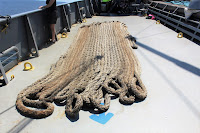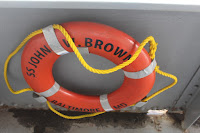 See my prior list (August 2011) of how to prepare for a huge hurricane here.
See my prior list (August 2011) of how to prepare for a huge hurricane here.The meteorologist, polymath, and weather expert Mike Smith has additional steps he recommends at the Mike Smith Enterprise Blog.
I repeat his suggestions below. Visit his website for updates. He's brilliant at knowing the weather and its impact on our lives.
There are many
excellent hurricane prep lists out there. Here are my suggestions for things to
do at this point with
the storm about 2.5 - 3 days away. Most of the things I recommend will
eventually be used even if the storm does not affect your specific
location.
- Get prescriptions refilled now, especially if you doctor must approve the refill.
- Toss out any expiring food, clean cat litter boxes, empty all trash cans in the house, including bathrooms. Otherwise the odors could get bad.
- Gather your utility bill (proof of current residency!), passport and any other important papers so you can take them with you if you should have to evacuate due to the hurricane’s winds and/or the hurricane’s flooding. Put together a "go kit."
- If you are in the hurricane wind area, see this information for preparing your home.
- Prepare bottles of water by filling them 90% (allowing for expansion when they freeze) and putting them in your freezer. They will keep the freezer cool longer if the power fails. They will also serve as emergency water. Freezers stay cold longer when full. So, if you have two freezers, consider consolidating the contents.
- Pet food and supplies? I'm not an expert in pets so I leave that to you.
- Batteries for everything. Lots of batteries. Full charge for cell phone and laptop. Keep them fully charged.
- If you have a relative at home that requires electricity for life-assistance purposes, you may want to move he or she outside of the higher wind zone.
- If you can get an electrician to install a generator, get it done. Do not try to install a generator yourself.
- If you don't have a generator, get a power inverter or two. Radio Shack and similar stores sell them. They are a "poor man's generator" and will keep your cell phone, laptop, and similar items charged. Tell the person in the store what you want to run off it so you get one of the right size. Do not try to run the inverter for hours at a time as that is tough on your car's battery. Charge the (for example) cell phone and let the charge run all the way down, then use the inverter to recharge.
- Keep your car's gas tank full.
- If you have a wood-burning fireplace and you know your chimney is clear, get wood. Keep some indoors to keep it dry during the storm. You may need it to heat your home, especially since the power failures could last for weeks in some area (i.e., toward the first of October).
- If you live in a 250-year flood plain (you can check at city hall or your library) or on the coast figure out your evacuation strategy now. Make your list of things you will take with you. Be prepared to leave at short notice. Have a paper map of the region as your first choice of evacuation routes may be cut off.
- Fill a few gas cans (the type you would use for your mower) to have extra in the event of power failures for your auto or generator.
- Purchase extra food staples. Without power, stores will be closed. Things that require less preparation are better. Bottled water is especially important.
- Purchase booster batteries for your cell phone and other essential equipment. If you need insulin or other medicine that must be kept chilled make plans now!
- Consider what you would do if you were without electricity for a month. If you have an invalid living with you that requires electricity, there will be areas that will be without for weeks. Be proactive.
- If you live in a heavily wooded area, does someone in your vicinity have a gasoline-powered chain saw? Does it have fuel and a reasonably good chain/blade? Test it, now.
- Get to an ATM. Without power, credit card readers and ATMs will not be working. In a disaster, cash is king!
- If you are in the high forecast wind area, thoroughly photograph your home and possessions now. You will need it for insurance purposes. This includes trees, shrubs, etc. Then, if using a digital camera, upload to internet so it will be there after the storm in case the worse happens. You can use it then to document damage for insurance purposes if the worst occurs.
- Stay away from downed power lines!
- If you evacuate, turn off the main water line.



Here is additional information on Mike Smith from his website.
Here is some information from our parish Emergency
Preparedness Expert-
Prepare spiritually and physically. Pray. Pray always, and if you don't, an
earthquake and major hurricane within one week should make you begin. Here is
how you may prepare physically.
Hurricane Irene is forecast to impact the State of Maryland this weekend.
Although there are still uncertainties in the final track of the storm, we urge
all residents to begin to prepare now. Please remember that this is a
large and powerful storm and it will not need to pass directly over Carroll
County to cause heavy rainfall and high winds. You can receive up to date
information on Hurricane Irene directly from the National Hurricane Center at http://www.nhc.noaa.gov
and your local National Weather Service office at: http://www.erh.noaa.gov/phi/.
Also, see the VueToo and Meteorological Musings (Mike Smith) link below.
Additional information can also be found at.
Please consider the following items as you prepare for Irene.
Make sure your family, friends and other important phone numbers are available.
Know where your family, friends and neighbors are in case you need them or they
need you.
Have emergency supplies ready BEFORE the storm.
Check your emergency kit. Learn more about what to keep in your kit at http://www.ready.gov
Ensure that insurance information is current and stored in a safe
location.
Secure any outdoor items.
Check and clear rain gutters and drains.
Check the serviceability of sump pumps if your home has one.
If you must leave your home, do not cross flooded roadways.
Ensure that you are registered to receive emergency notifications
from the Department of Emergency Services at http://www.ccdes.org
Earthquakes: Do not call 911 for information about the earthquake, only to
report an emergency.
If you smell gas or suspect a gas leak:
Leave the area immediately and go to a location where you no longer smell gas,
and report the leak by calling 911 (If Fire Rescue is not already on the
scene).
In any event: Do Not:
Light matches or smoke. Avoid use of all open flames.
Try to locate the source of the gas leak.
Use any electrical device, including cellular phone, I-pods etc.
Turn light switches On and Off.
Re-enter the building or return to the area until it has been
declared safe to do so by Fire Rescue Personnel











































































































































































